Jan 01, 2026
Jan 01, 2026
The Down-to-Earth Explanation
Isaac Newton, that brilliant 17th-century thinker with the wild hair and the penchant for apple-related thought experiments, gifted us a profound insight: the law of universal gravitation. This law elegantly describes how objects attract each other due to their masses. But let’s break it down without invoking any numbers or equations—just everyday experiences.

We don’t have to be a qualified scientist to experiment with the world. Humans are curious about the world, and we derive joy from satisfying our curiosity. It is more rewarding if we can work out things for ourselves and share that journey of discovery with the world.
1. The Apple and the Tree
Imagine you’re sitting under an apple tree, pondering life’s mysteries. Suddenly, a ripe apple detaches from its branch and falls toward the ground. Newton would have been proud! Here’s what’s happening:
2. Earth’s Embrace
Now, let’s step away from apples and consider our own existence:
3. Orbits and Celestial Ballet
Newton’s law isn’t just about apples; it’s cosmic ballet time:
4. Falling Leaves and Falling Stars
Nature is full of gravity’s subtle whispers:
5. The Universal Handshake
Newton’s law isn’t just for Earth; it’s universal:
6. Einstein’s Twist
But wait, there’s a plot twist! Enter Einstein:
So, dear friend, next time you see an apple fall or gaze at the Moon, remember Newton and Einstein. They unraveled gravity’s secrets, allowing us to appreciate the cosmic dance that keeps us grounded and our universe spinning.
And hey, if you ever find yourself pondering gravity while sipping tea, just remember: Newton did it under an apple tree.
Image (c) istock.com
07-Sep-2024
More by : Shalini Vohra

|
Well written article. Interesting and informative. Excellent. |